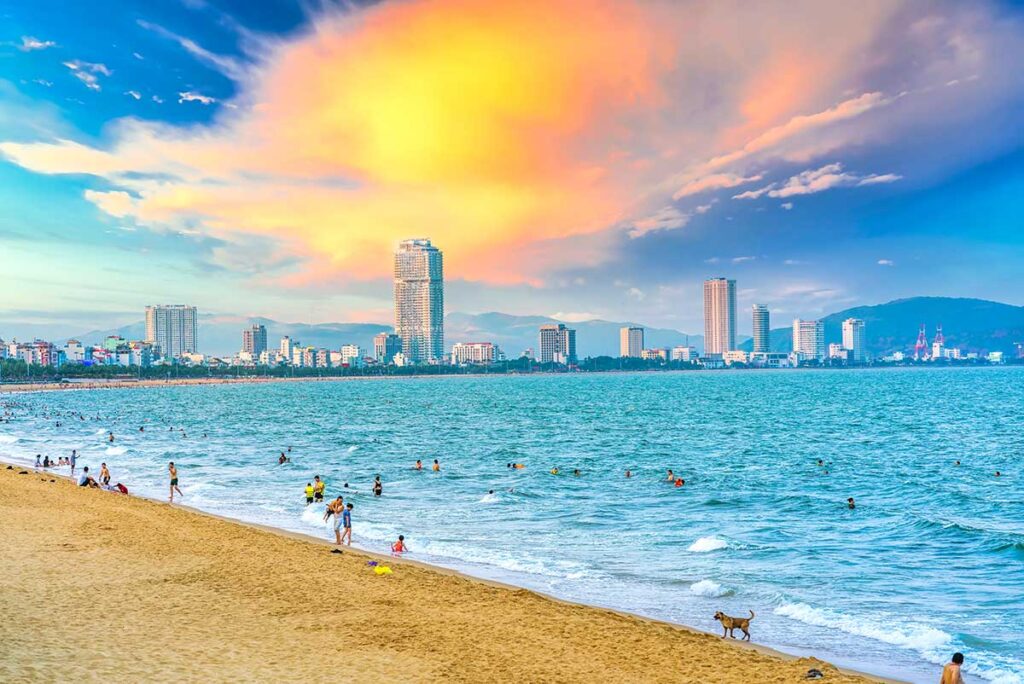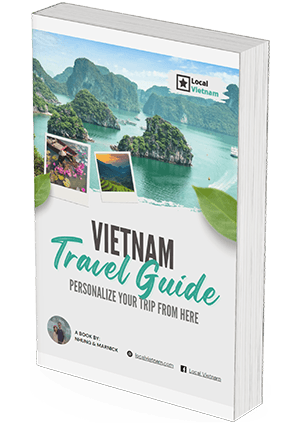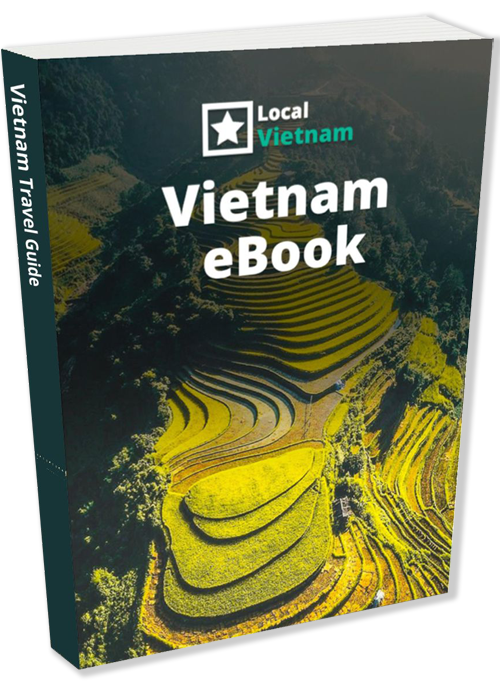Quy Nhon – Beaches, Fishing Villages & Cham Heritage
Quy Nhon is a coastal city in Bình Định Province, framed by sandy beaches, rocky peninsulas, and small offshore islands. Once part of the Cham kingdom of Vijaya, the area still preserves striking Cham towers alongside its fishing heritage. The city itself feels relaxed and authentic, with wide seafront boulevards, a busy fishing port, and a local rhythm that contrasts with bigger tourist hubs like Nha Trang or Da Nang.
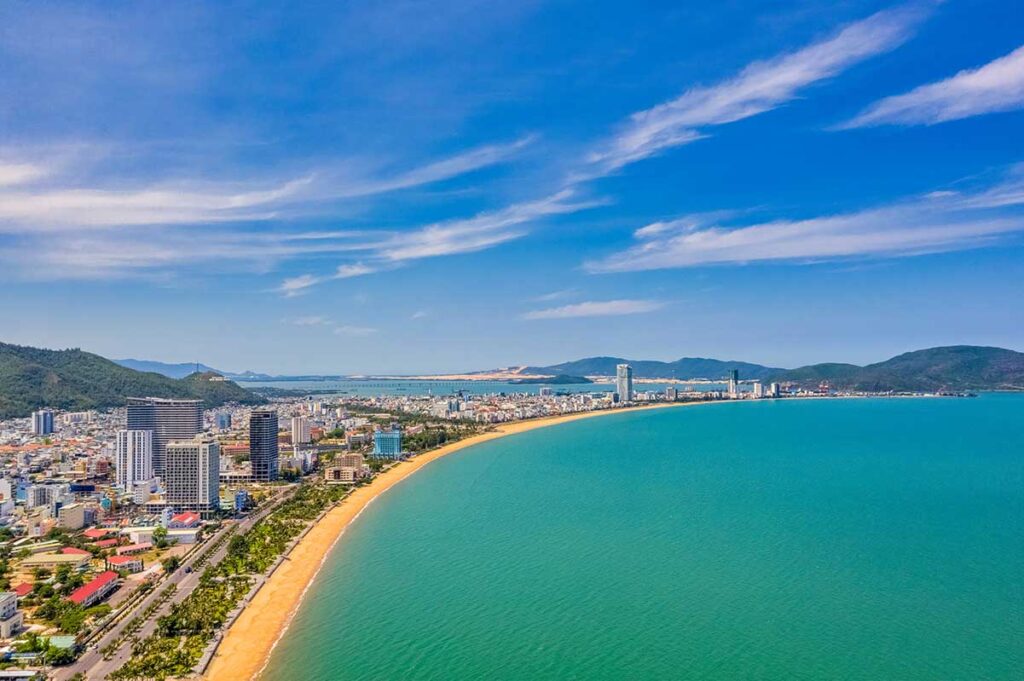
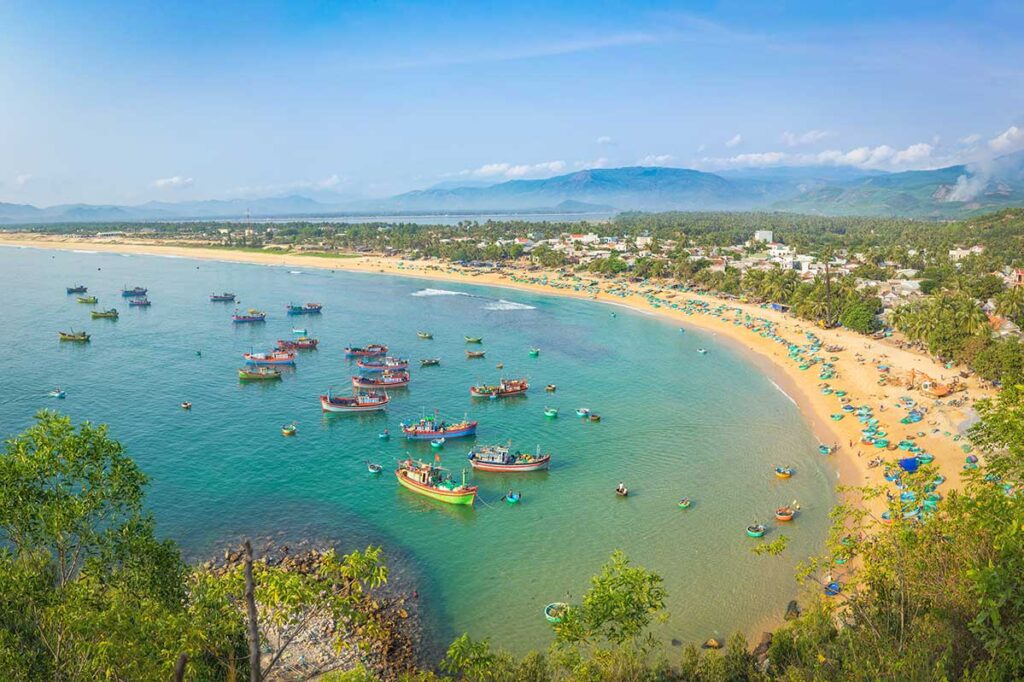
Beyond the city, traditional fishing villages, quiet beaches, and dramatic coastal cliffs define the region. Tourism is growing but still low-key, with most visitors being domestic travelers. For international travelers, the best things to do in Quy Nhon include exploring the coastline, visiting Cham sites, and experiencing daily life in seaside communities.
Best things to do in Quy Nhon
The best things to do in Quy Nhon combine beautiful beaches, authentic fishing villages, and unique Cham heritage. Some spots are wonderfully quiet while others draw big weekend crowds, and facilities can be basic once you leave the city. That mix of unpolished charm and natural beauty is exactly what makes Quy Nhon stand out from more developed coastal destinations in Vietnam.
1. Enjoy Quy Nhon City
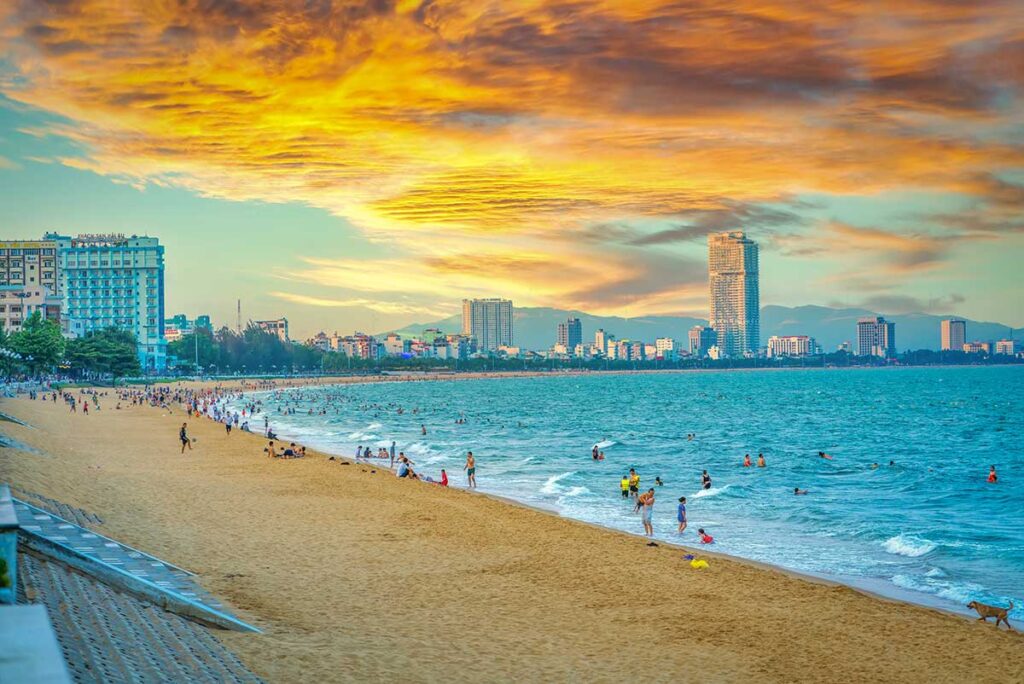
Quy Nhon is a laid-back coastal city with a wide beachfront promenade, a working port, and plenty of places to enjoy seafood. It feels more local than touristy, but that’s part of the appeal.
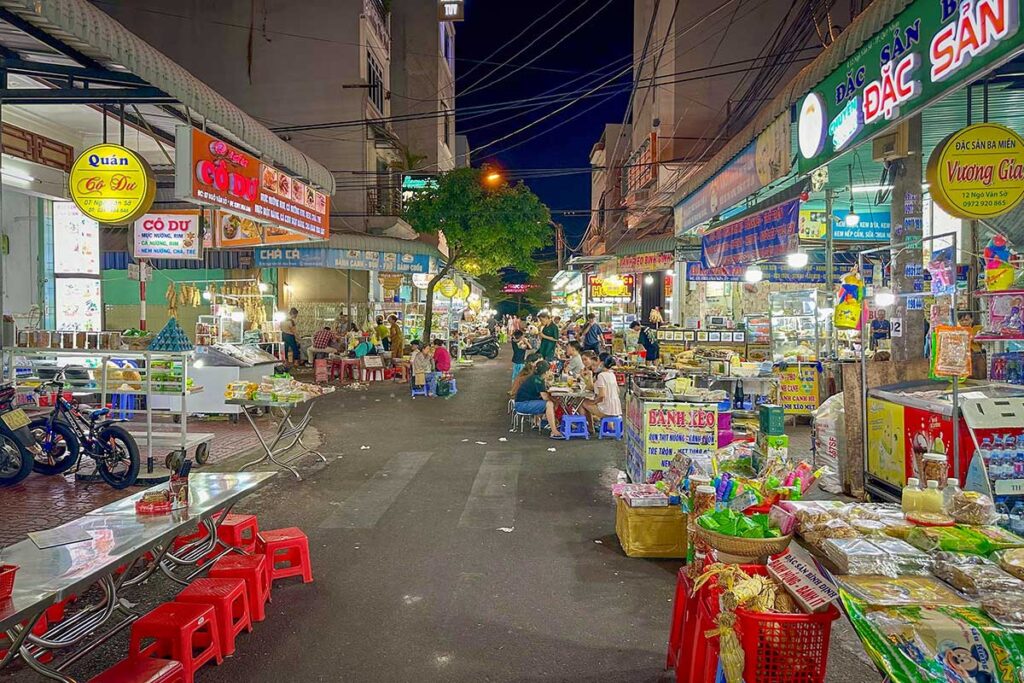
- Relax at Quy Nhon’s main beach (Municipal/Xuân Diệu): The long city beach curves along the center with calm water and a lively evening scene when locals come out to swim or stroll. It’s best enjoyed early morning or late afternoon when the sun is softer, and you’ll find cafés and simple beach chairs right by the sand.
- Try fresh seafood (Xuan Dieu strip & local eateries): Eating seafood here is as much a part of local life as the beach. Signature dishes include crispy bánh xèo tôm nhảy and bún chả cá noodle soup. Many restaurants charge by weight, so it’s worth checking prices first, but the quality is usually excellent if you stick to busy spots.
- Cham Twin Towers (Tháp Đôi): Just a short ride from the seafront, these 12th–13th century Cham towers are the easiest historical site to visit in the city. The red-brick architecture stands out against the modern surroundings, and they’re best seen in the late afternoon light.
2. Explore Amazing Beaches Around Quy Nhon
The city beach is pleasant, but the real highlights lie on the surrounding peninsulas and villages. Exploring further out gives you some of the best things to do in Quy Nhon, from quiet coves to long sandy stretches where local life is still strong.
Bai Xep Beach
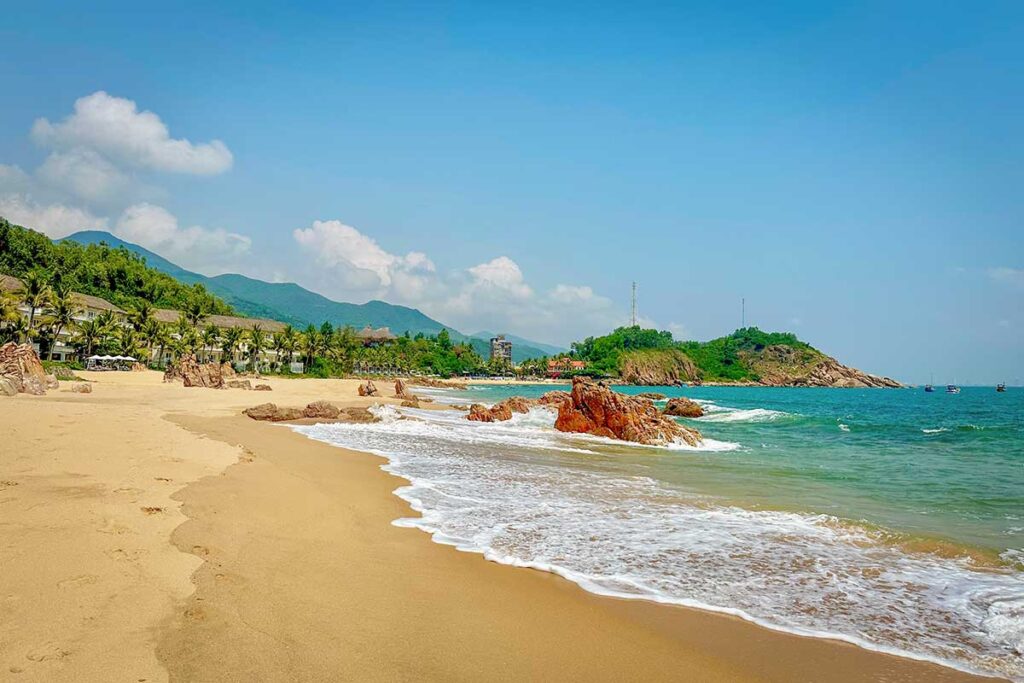
Bai Xep is a small fishing village about 12 km south of the city, with a golden sandy cove that feels relaxed and low-key. Simple homestays and beach bars sit right by the shore, making it a great place to spend the night if you want a quieter atmosphere than the city. Bring cash, as there are no ATMs, and expect basic but charming facilities.
Ky Co Beach
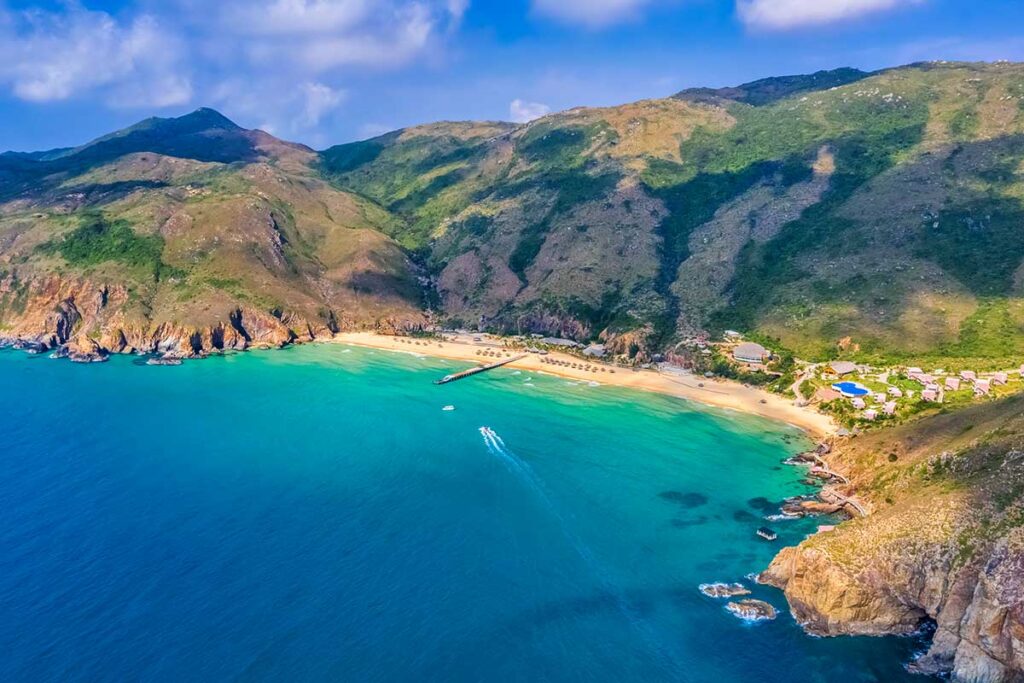
Often called one of the most beautiful beaches in Vietnam, Ky Co is famous for its turquoise water and photogenic setting. It’s also one of the busiest places near Quy Nhon, with high entrance fees by local standards and plenty of tour groups. To enjoy it, arrive early in the morning before the crowds, and don’t expect much in the way of peace and quiet.
Cat Tiến / Nhơn Lý Beach
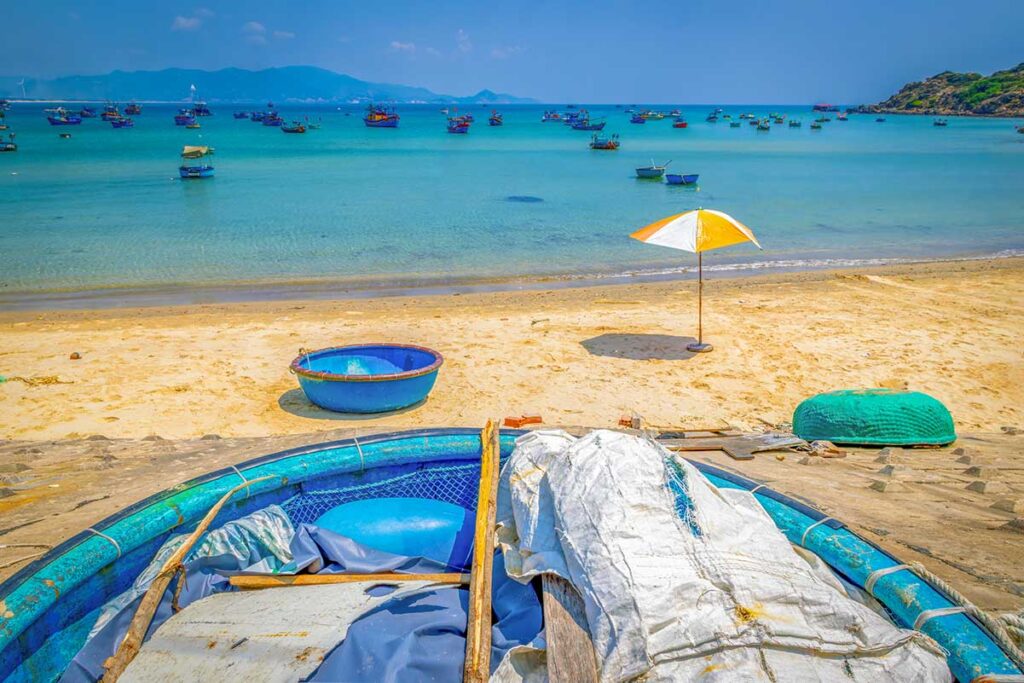
North of the city, Cat Tiến and Nhơn Lý offer wide sandy beaches backed by fishing villages. They’re less polished than Ky Co but much quieter, giving a more authentic feel of the local coast. Getting there is easiest by motorbike or private driver, and shade is limited, so it’s worth packing a hat or umbrella if you want to spend longer by the water.
3. Visit Ancient Cham Remains
The Cham kingdom once ruled much of central Vietnam, and Quy Nhon was at the heart of the Vijaya capital. Today, you can still see impressive Cham towers scattered around Bình Định Province, often standing on hilltops with sweeping views of the coast. Visiting them is one of the most atmospheric best things to do in Quy Nhon, especially if you’re interested in history and architecture.
Cham Twin Towers (Tháp Đôi)
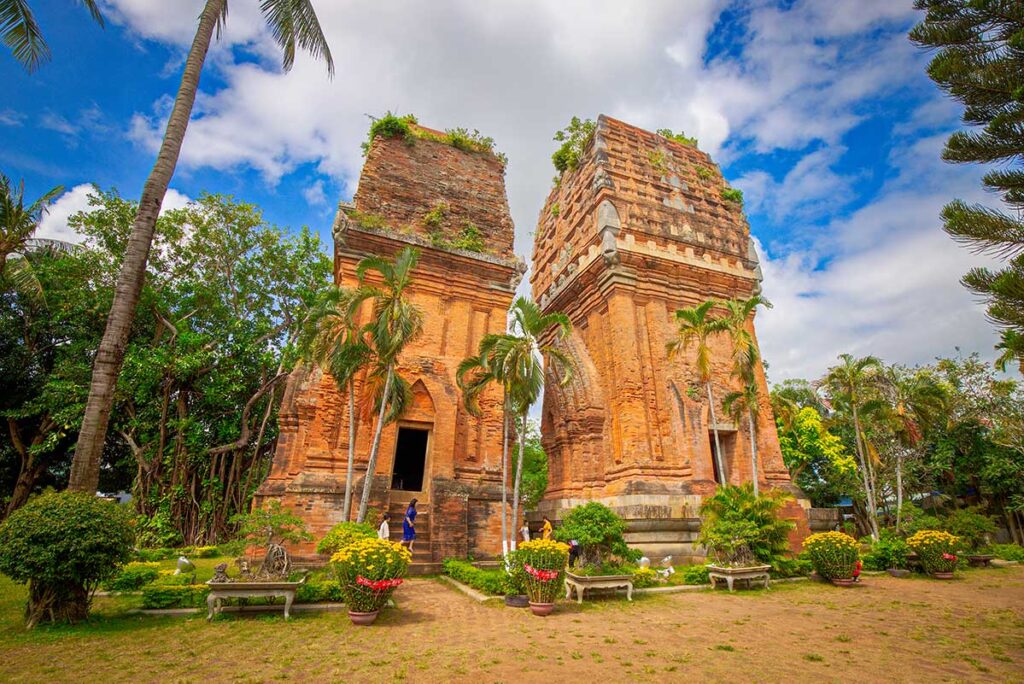
Located right in Quy Nhon City, these two towers are the easiest Cham site to visit. Built in the late 12th–13th century, they show the red-brick construction typical of Cham architecture. It’s a quick stop that combines well with a walk along the city’s seafront, and the late afternoon light gives the towers a beautiful glow for photos.
Banh It Towers (Tháp Bánh Ít)
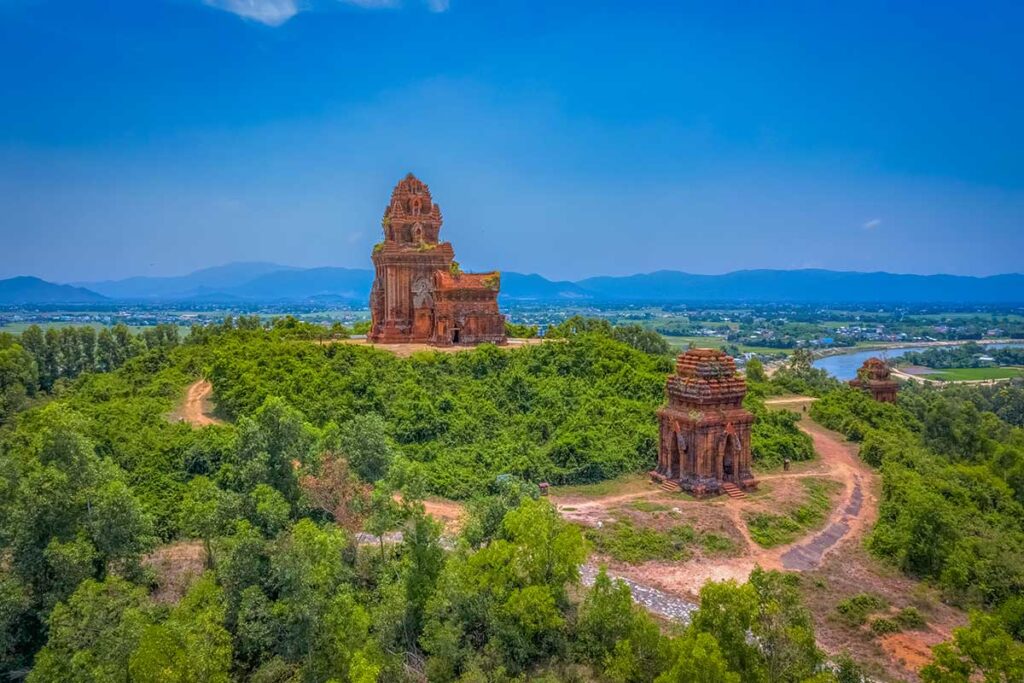
This complex sits on a hill about 20 km outside the city, with several towers overlooking the countryside. The climb up is worth it for both the history and the panoramic views of rice fields and villages. There’s little shade and the steps can be hot in the middle of the day, so bring water and plan a morning or late-afternoon visit.
Duong Long Towers (Tháp Dương Long)
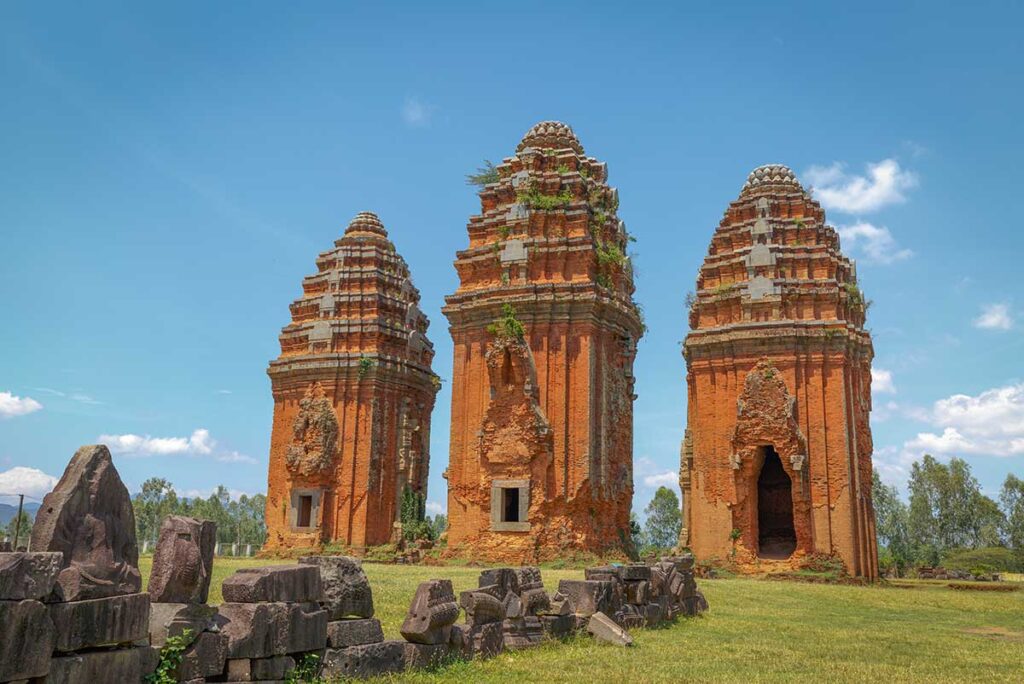
Standing over 40 meters high, these are among the tallest Cham towers in Vietnam and an impressive sight despite their remote location. They date from the 12th–13th century and are best visited as part of a longer trip inland. Facilities are limited and the site often closes during the midday hours, so time your visit carefully and combine it with the Quang Trung Museum or Thien Hung Pagoda nearby.
4. Discover Authentic Fishing Villages & Local Life
Outside the city, Quy Nhon is defined by its coastal communities. Fishing villages here still launch basket boats at dawn, repair nets on the beach, and sell fresh seafood at simple local stalls. Exploring these villages gives you a sense of everyday life in Bình Định and is one of the most rewarding best things to do in Quy Nhon.
Nhon Hai Fishing Village
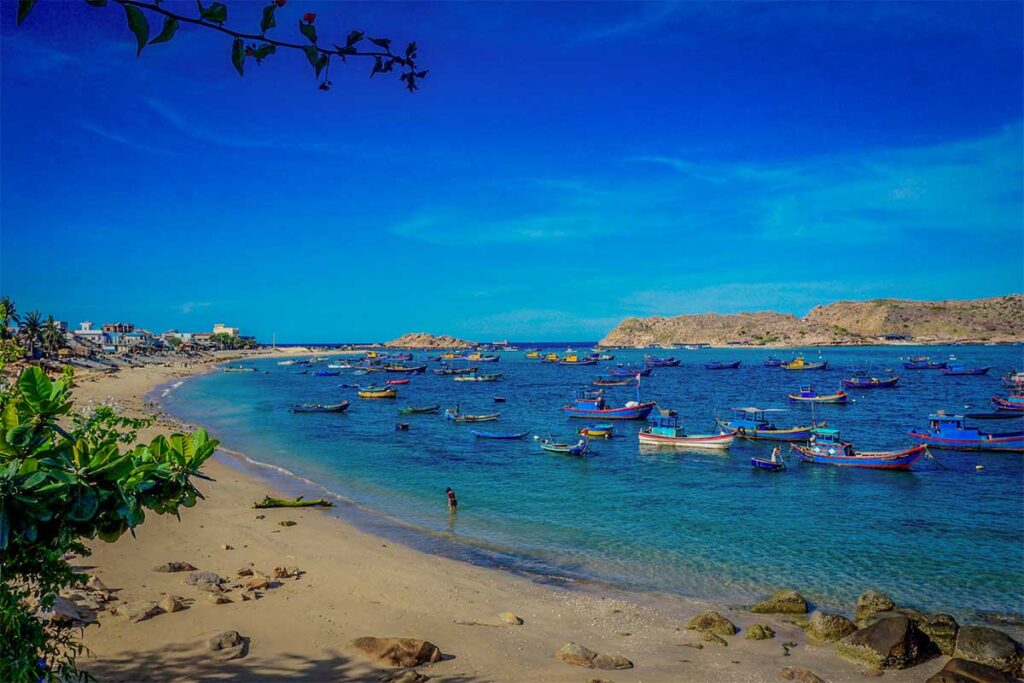
Just north of the city, Nhon Hai is a lively fishing village with a sandy beach and a calm bay protected by an island offshore. It’s also the jumping-off point for boat trips to Hon Kho Island. Services are simple—think small eateries and a few homestays—so it’s best to bring cash and make it a half-day or full-day trip combined with Ky Co or Eo Gio.
Nhon Ly Fishing Village
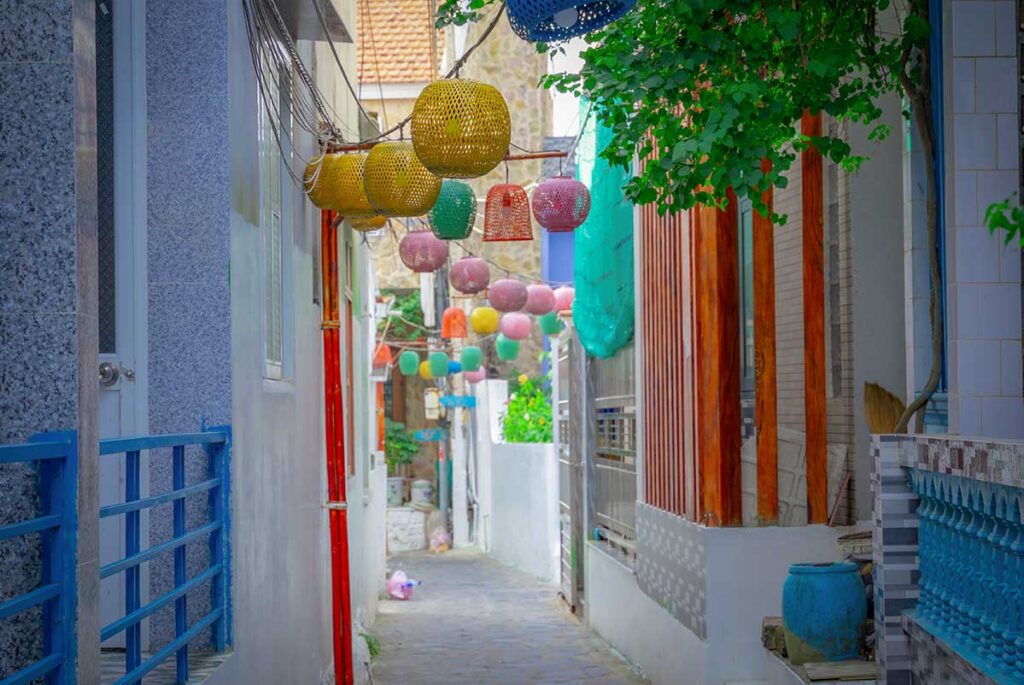
Next to Eo Gio, Nhon Ly is another traditional fishing community. The village backs a long sandy beach and serves as the main land access point for Ky Co. It’s easy to fit in a short walk through the village when visiting the other sights, but expect basic facilities and a lot of activity in the mornings when boats return.
An Quang (near De Gi Beach)
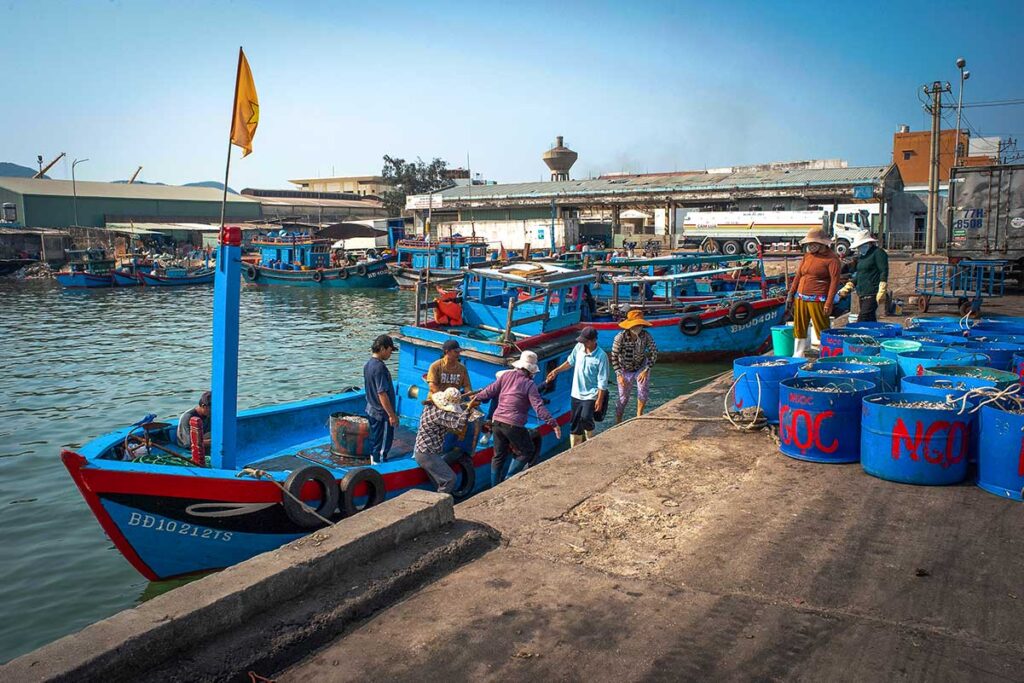
Farther north along the coast, An Quang is quieter and sees very few visitors. It’s still very much a working fishing area, with fleets of wooden boats offshore and nets drying on the sand. The remoteness means almost no tourist services, so this is best for travelers with their own motorbike or car and a sense of adventure.
5. Soak Up the Most Stunning Coastal Views
One of the big draws of Quy Nhon is its dramatic coastline. Cliffs drop into turquoise bays, peninsulas stretch far out to sea, and on clear days you can spot islands dotting the horizon. Driving or walking along these stretches of coast is not only scenic but also gives a sense of how untamed much of Bình Định’s landscape still is.
Eo Gio
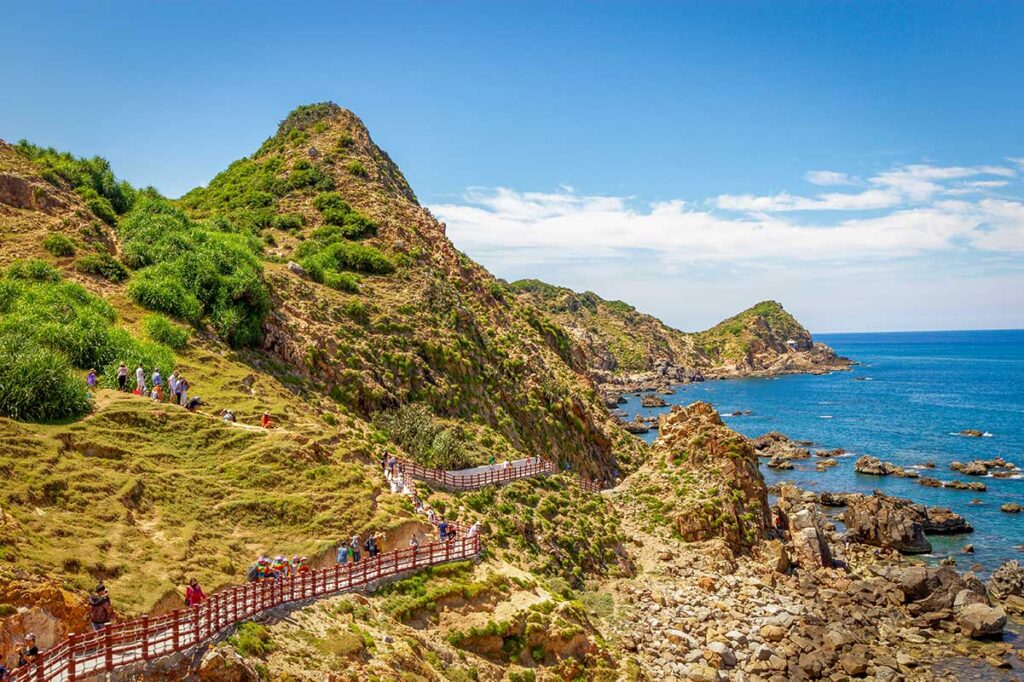
Eo Gio, or “Windy Pass,” is the most famous viewpoint near Quy Nhon. Wooden boardwalks wind along rocky cliffs, with waves crashing below and excellent spots for photos. It can be crowded at weekends and on holidays, so sunrise or sunset is the best time to enjoy it with fewer people. Sturdy footwear makes exploring easier, as parts of the path can be uneven.
The Coastal Highway Drive (QL1D & spurs)
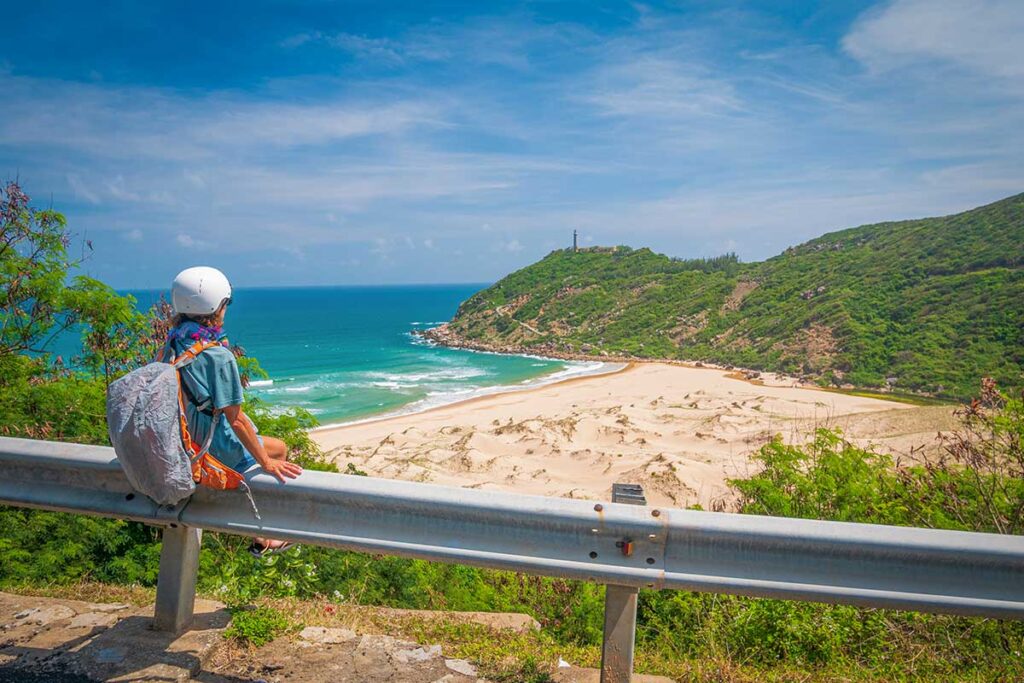
South of Quy Nhon, the coastal road winds past fishing villages and endless beaches, making it one of the most beautiful drives in Vietnam. The stretch into neighboring Phu Yen Province is especially scenic. Confident riders can explore by motorbike, but if you’re less comfortable on two wheels, hiring a driver for the day gives you the same views without the stress.
6. Go Island Hopping
Several islands lie just offshore from Quy Nhon, offering clear water, coral reefs, and a more remote feel than the city beaches. A day of island hopping is one of the best things to do in Quy Nhon if you enjoy snorkeling or simply want a change of scenery.
Hon Kho Island
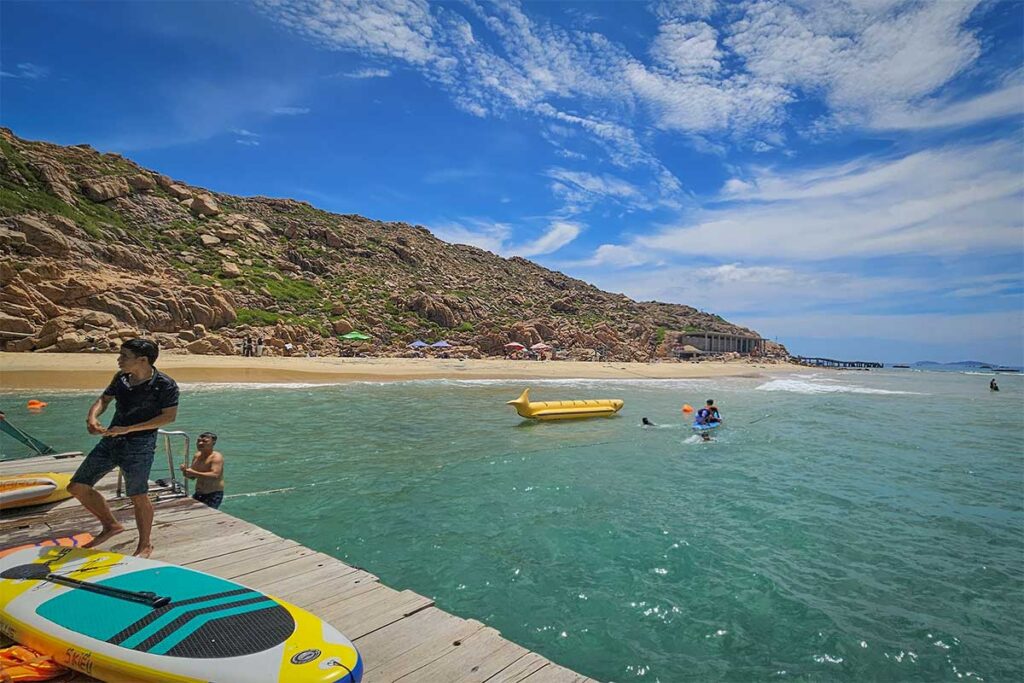
Reached by a short boat ride from Nhon Hai Fishing Village, Hon Kho has sandy stretches, rocky corners, and some coral that’s still in good condition. Snorkeling is the main activity here, though visibility depends on the season. There are basic seafood shacks on the island, but it’s best treated as a half-day trip combined with time in Nhon Hai.
Hon Seo Island
Smaller and less visited than Hon Kho, Hon Seo appeals to travelers looking for a quieter outing. The island is ringed by shallow coral reefs and calm water on good weather days. Boats can be arranged through local operators, but facilities are almost nonexistent—bring water, snacks, and reef-safe sunscreen.
Cu Lao Xanh (Nhon Chau Island)
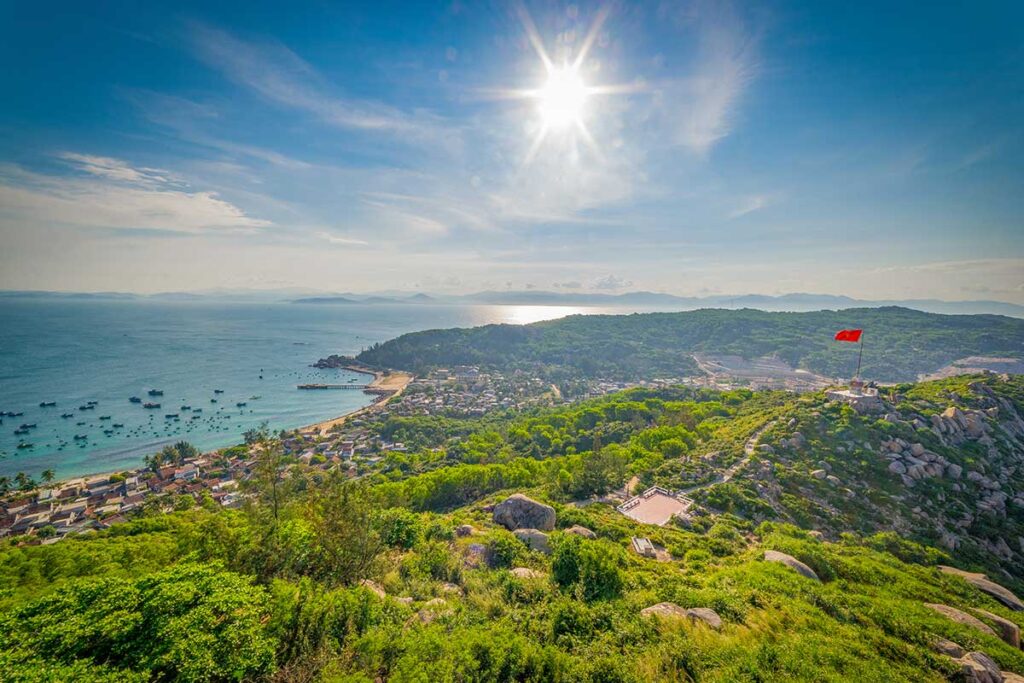
Cu Lao Xanh is the largest island near Quy Nhon, with emerald water, sandy beaches, and a French-built lighthouse that overlooks the coast. It feels more like a small community than just a beach spot, but access for foreigners can be tricky—regulations sometimes require permits or tours, and rules are not always consistent. If you do get the chance to visit, plan a full day and expect simple local conditions rather than resort-style services.
7. Temples & Pagodas
Binh Dinh is better known for its beaches and Cham towers, but there are also several striking Buddhist sites. They’re worth adding if you’re looking for cultural variety or combining with nearby attractions.
Ong Nui Temple (Linh Phong)
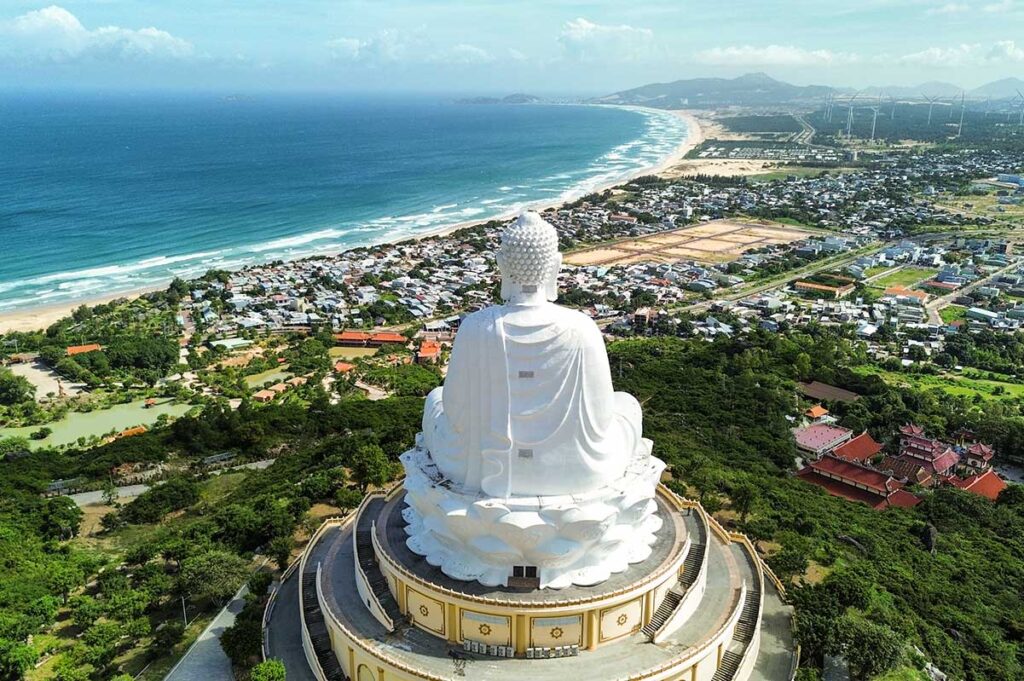
Ong Nui Temple is famous for its huge seated Buddha statue overlooking the sea from a hillside. Reaching it involves climbing hundreds of steps, which is best done early in the morning before the heat sets in. Modest dress is expected, and combining a visit with nearby Ky Co or Eo Gio makes for an efficient day.
Thien Hung Pagoda
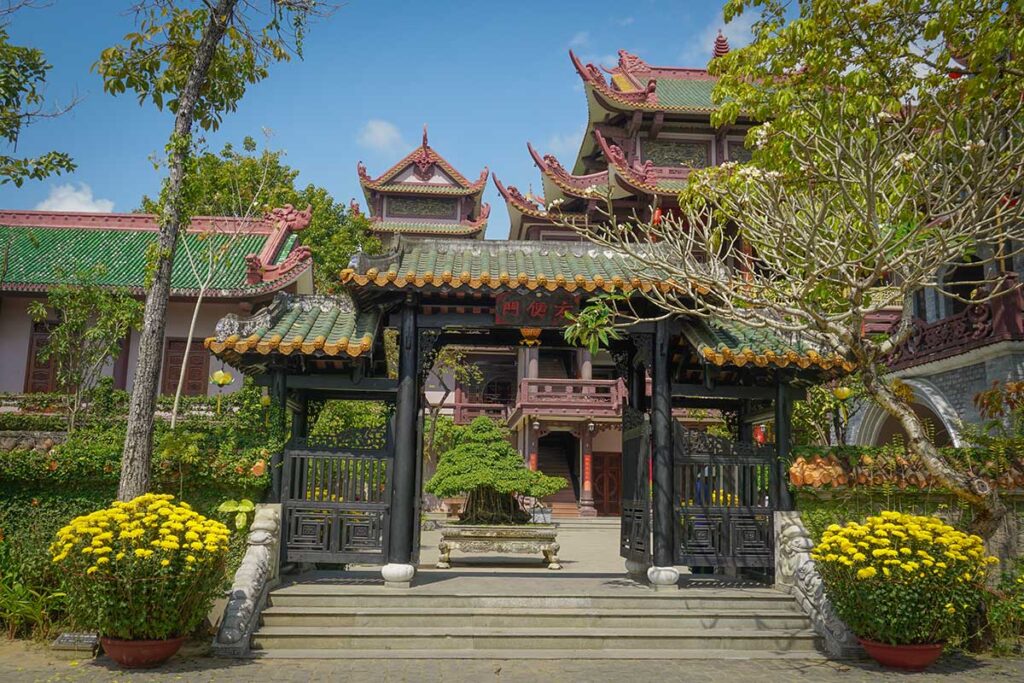
Located inland near An Nhon, Thien Hung Pagoda is one of the newer but more visually impressive pagodas in the region. Its tall tower and landscaped grounds make it a striking stop, though it’s a bit out of the way. It works best as a combined trip with Duong Long Cham Towers and the Quang Trung Museum.
8. Phuong Mai Sand Dunes
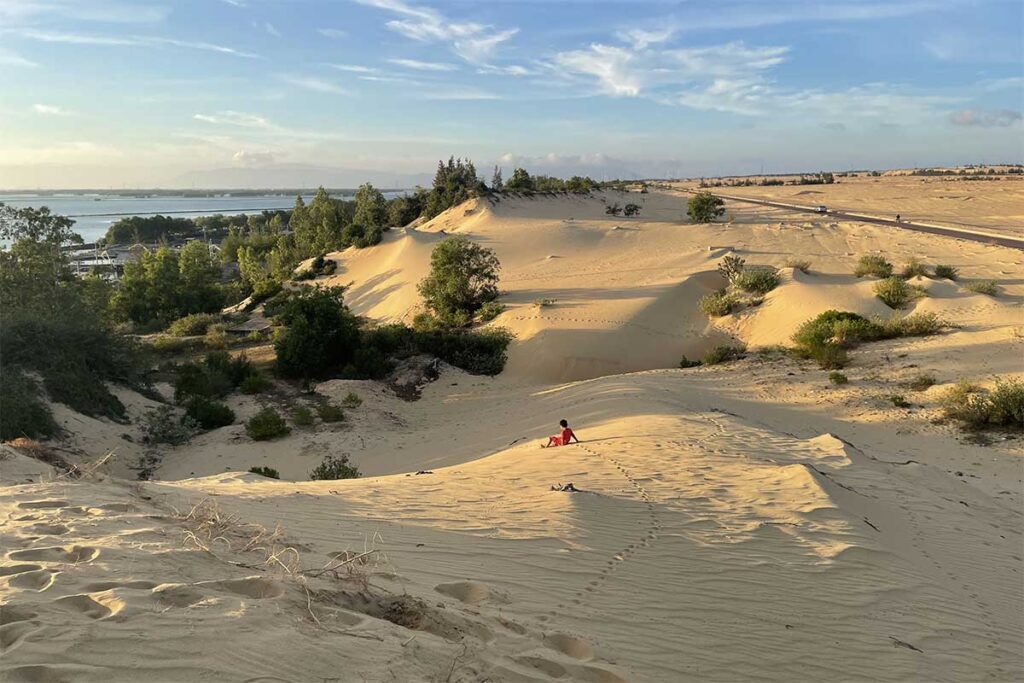
The Phuong Mai Sand Dunes cover part of the peninsula near Nhon Ly and offer rolling golden hills that make for striking photos. Unlike Mui Ne, there aren’t many activities here—no quad bikes or dune buggies—so most visitors come for a short walk and a look at the scenery. The dunes are close to Ky Co, Eo Gio, and Nhon Hai, so they’re easy to combine with other stops on the same day. If you’ve already seen larger dunes elsewhere in Vietnam, they may not impress as much, but they’re still a fun addition to a coastal loop.
9. Quang Trung Museum
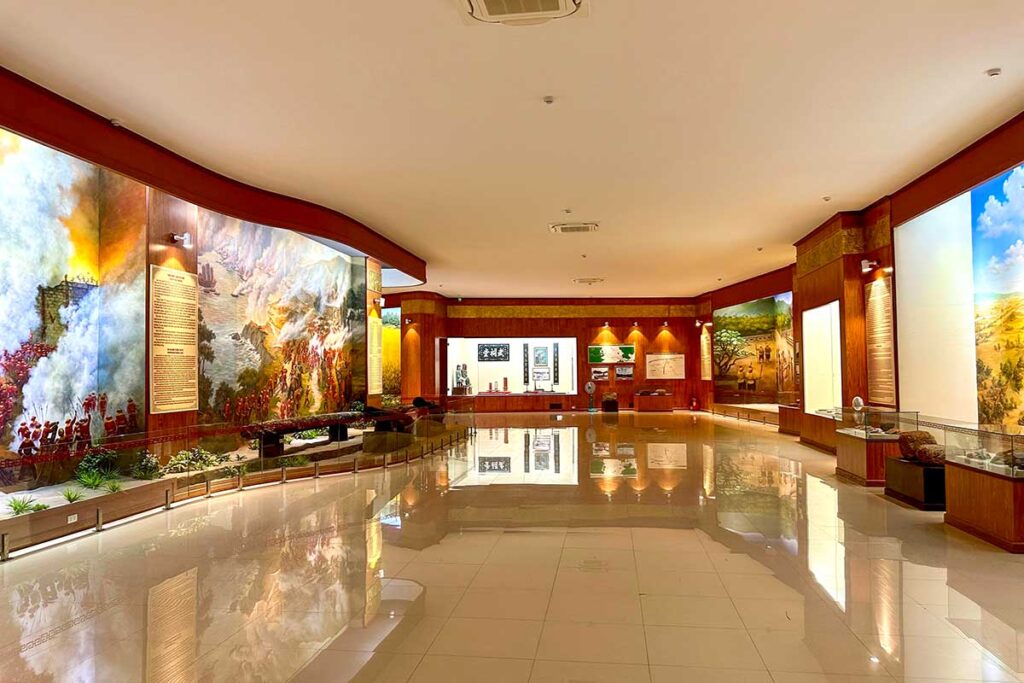
Located inland in Tay Son District, this museum is dedicated to Emperor Quang Trung and the Tay Son Rebellion of the 18th century. Exhibits include artifacts, statues, and a panorama painting of major battles. It’s the best museum in Binh Dinh, but it’s far from the city, so only history enthusiasts will find it worth the journey on its own. A smart way to visit is to pair it with Duong Long Towers and Thien Hung Pagoda in a single day trip.
10. Trekking in Kon Chu Rang Nature Reserve

For travelers who want something far beyond the beaches, Kon Chu Rang offers dense jungle, rivers, and one of Vietnam’s most spectacular waterfalls, K50. It’s a protected area with limited infrastructure, so visits usually involve trekking with a guide, and sometimes camping overnight. The scenery—towering forest, hidden pools, and the dramatic falls—makes it one of the most rewarding but least developed adventures near Quy Nhon. This is not a casual outing, but for nature lovers it’s one of the best things to do in Binh Dinh Province.
Best time to visit Quy Nhon
Because many of the best things to do in Quy Nhon are outdoors—beaches, islands, and coastal viewpoints—the weather plays a big role in how enjoyable your trip will be. Calm seas and sunshine make for ideal swimming and snorkeling conditions, while heavy rain or wind can limit boat trips and beach time.
Dry season (January–August)
From January through August, Quy Nhon enjoys long stretches of sunny days with clearer water for swimming and snorkeling. Conditions are most pleasant from January to April, while May to August brings hotter afternoons and stronger coastal winds. This is the prime time for beach hopping and island trips, but it’s best to plan activities for mornings or late afternoons to avoid the peak heat. Domestic travelers often come on weekends and holidays, so booking accommodation in advance during these months is a smart idea.
Rainy season (September–December)
The rainy season starts in September and peaks around October and November, when storms and rough seas are more likely. Some boat tours stop running, and beach conditions can be less inviting. That said, city walks, Cham towers, and museums are still enjoyable, and rain showers are often broken up by clear intervals. If you travel in these months, keep your schedule flexible and check the daily forecast, as a sunny morning can quickly turn into an afternoon downpour.
How to get to Quy Nhon
Quy Nhon is well connected by air, train, and road, making it relatively easy to include in a Vietnam itinerary. Each option has its pros and cons depending on your route, budget, and travel style.
Flying to Quy Nhon (Phu Cat – UIH)
The quickest way to reach Quy Nhon is by air. Phu Cat Airport (UIH) is a domestic airport about 35 km from the city, with frequent daily flights from both Hanoi (around 1.5 hours) and Ho Chi Minh City (around 1 hour). From the airport, it takes 45–60 minutes by taxi or shuttle bus to reach the city center or Bai Xep area. Shared shuttles are cheaper but less flexible, while taxis or private transfers are more convenient if you’re traveling with luggage.
By Train
Although Quy Nhon has a small railway station, it only sees one train per day, so most travelers use Diêu Trì Station about 10 km inland. Diêu Trì is on Vietnam’s main north–south line, with regular services linking major cities. From the station, you can reach Quy Nhon in about 30 minutes by taxi or local bus. Popular routes include:
- Hanoi – Diêu Trì: around 20–22 hours
- Da Nang – Diêu Trì: around 6–7 hours
- Nha Trang – Diêu Trì: around 4–5 hours
- Ho Chi Minh City – Diêu Trì: around 11–12 hours
By Bus
Quy Nhon is also easy to reach by road, with regular buses and limousine vans connecting coastal and inland cities. For shorter trips, such as Nha Trang, luxury vans are the most comfortable choice. For longer distances, sleeper buses are the standard option. Approximate travel times include:
- Nha Trang – Quy Nhon: 4–5 hours
- Hoi An/Da Nang – Quy Nhon: 7–9 hours
- Da Lat – Quy Nhon: 7–8 hours
- Pleiku (Central Highlands) – Quy Nhon: 3–4 hours
How to get around
Quy Nhon is fairly easy to navigate, whether you stay within the city or explore the surrounding coastline. Your choice of transport depends on how far you want to go and how comfortable you are with local conditions.
Taxis & Ride-Hailing
Within the city, taxis and Grab cars are convenient for short rides, such as between your hotel, the beach, and restaurants. For trips to outlying beaches or temples, it’s best to ask the driver to wait or agree on a half-day rate, since return rides can be hard to find.
Car with driver (Day trips)
Hiring a private car with a driver is the easiest way to explore several sights in one day. This works especially well for the coastal loop that links Ong Nui Temple, Ky Co Beach, Eo Gió, and the Phuong Mai Sand Dunes. Prices are usually negotiated by the half-day or full day, and drivers are familiar with the main sightseeing routes.
Renting a motorbike
For those confident on two wheels, renting a motorbike is a rewarding way to see Quy Nhon’s coastline. Traffic is calmer than in larger Vietnamese cities, and the roads around the peninsulas are especially scenic. You’ll still need an international driving permit to be fully legal, and helmet quality can vary, so check before you set off. Sun and wind protection are essential if you plan to ride longer distances.
Walking
Inside Quy Nhon City, many hotels, eateries, and the main beach are close enough to reach on foot. Walking along the seafront promenade is pleasant, but shade is limited, so bring water and a hat. Traffic is lighter than in big cities, though it’s still wise to be cautious when crossing main roads.
Where to stay in and Around Quy Nhon
Accommodation around Quy Nhon ranges from city hotels to hidden beach resorts and simple village homestays. Where you stay can really shape your experience, whether you want convenience, seclusion, or an authentic coastal atmosphere.
Quy Nhon City
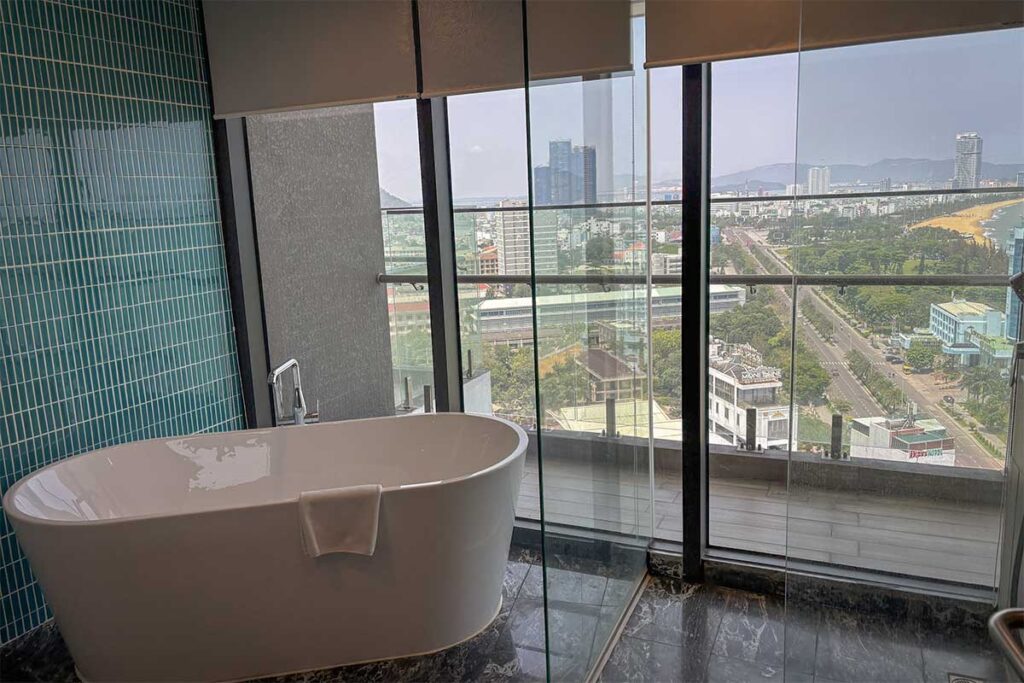
Staying in the city is the most practical choice, with easy access to the main beach, restaurants, and transport. Hotels here cover all budgets, from small guesthouses to high-rise sea-view resorts. It’s a good option if you like being close to dining and services, though weekend evenings can get noisy around the seafront when locals gather.
Resorts with private beaches
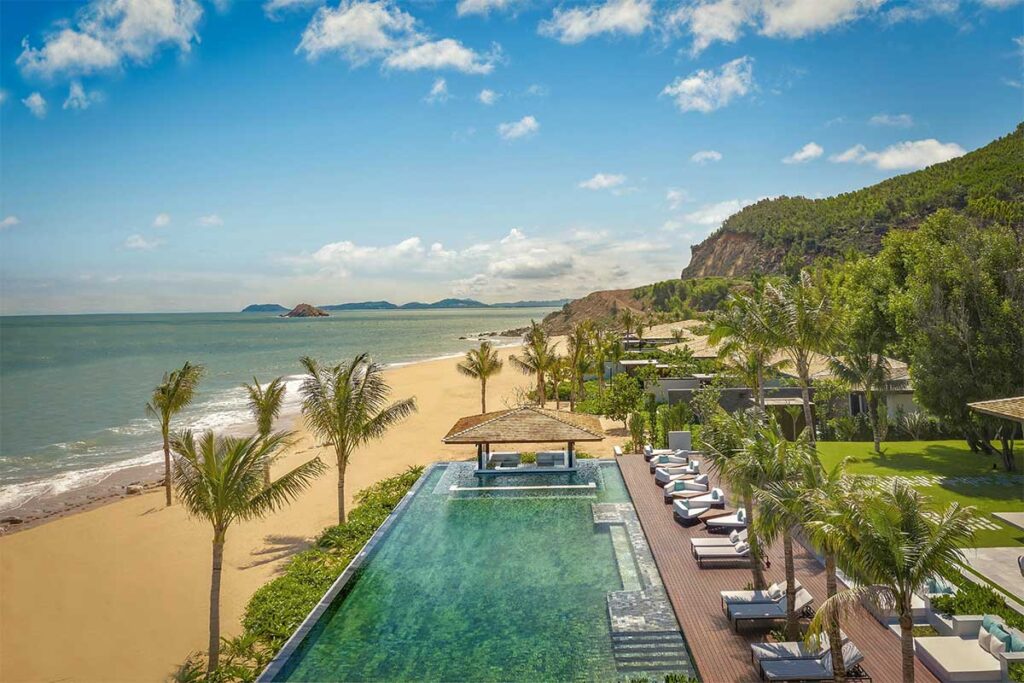
For a more secluded experience, several resorts are tucked into coves outside the city. These offer private beaches, swimming pools, and full facilities at higher rates. They’re ideal for couples or families who prefer to relax in one place, but transfers into town for meals or sightseeing take time and may require arranging transport with the hotel.
Local fishing villages (Bai Xep, Nhon Hai)
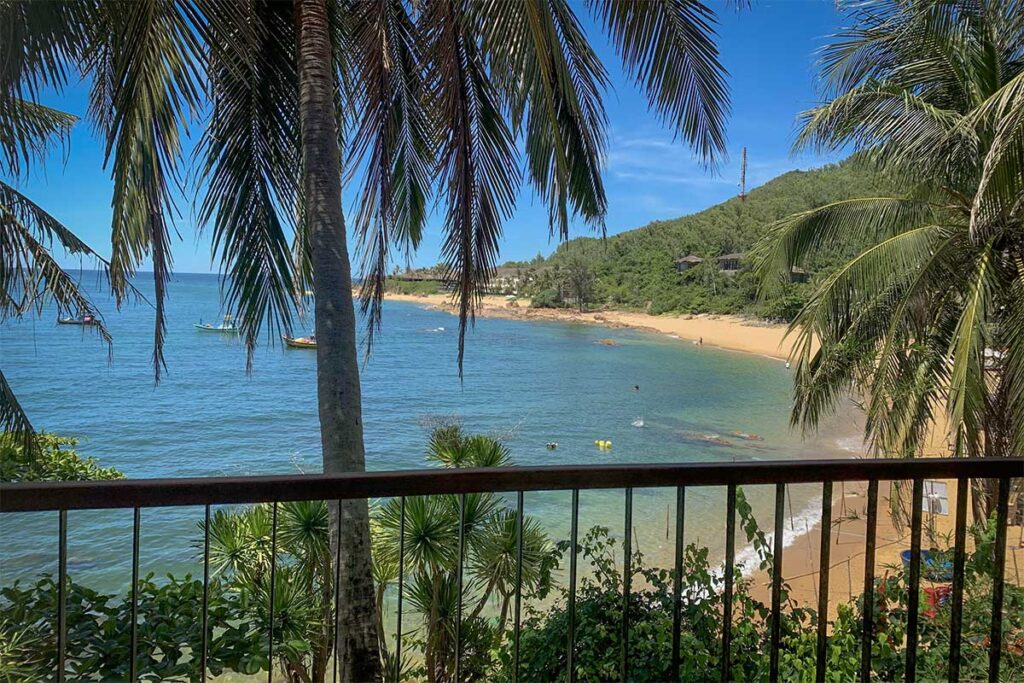
Staying in a fishing village like Bai Xep or Nhon Hai puts you right on the sand in a more authentic setting. The vibe is relaxed and simple, with small homestays, beach bars, and a few mid-range guesthouses. Services are basic—cash is essential and ATMs are scarce—but you’ll wake up to basket boats on the water and have easy access to snorkeling or boat trips. Nights are generally quiet, making these villages perfect for those who value atmosphere over convenience.
Practical visiting information & Travel tips
Food & Local dishes
Quy Nhon is known for its fresh seafood and a few unique local specialties. Don’t miss bánh xèo tôm nhảy, a crispy pancake with tiny jumping shrimp, or bún chả cá, a fish cake noodle soup that tastes lighter than versions elsewhere in Vietnam. Another favorite is chả ram tôm đất, small fried spring rolls filled with shrimp. For seafood, head to the strip along Xuan Dieu Street, where dozens of casual restaurants line the coast.
Money & Facilities
ATMs are widely available in Quy Nhon City but scarce in fishing villages like Bai Xep and Nhon Hai, so bring cash if you plan to stay there. The city also has pharmacies, minimarts, and a couple of modern shopping centers for basics. Mobile data is reliable, and hospitals are available in town, though facilities are limited compared to larger cities.
Safety & Etiquette
At the beach, pay attention to swim flags and avoid strong waves, especially during the rainy season. The sun and coastal wind can be strong, so hats, sunscreen, and hydration are essential. At temples and pagodas, wear modest clothing and cover shoulders and knees. In fishing villages, be respectful when taking photos—ask first if people are working or if you want to capture boats being launched.
Recommended stay length
Two full days are enough to see the main highlights: a day for the coastal loop (Ky Co, Eo Gio, Nhon Hai) and another for beaches or Cham towers. Travelers looking to relax can stretch this to three or four days, using the extra time to stay overnight in Bai Xep or Nhon Hai. For history or trekking fans, add an extra day to visit the Cham towers inland or Kon Chu Rang Nature Reserve.
Where to go next
Quy Nhon works well as part of a longer Vietnam route. To the north, you can travel to Hoi An or Da Nang by train or bus. South of the city lies Phu Yen, another underrated coastal province, and farther south is Nha Trang. Inland routes connect to Pleiku and the Central Highlands for a different cultural and natural experience. If you’re short on time, flights from Phu Cat Airport can quickly connect you back to Hanoi or Ho Chi Minh City.
2-Day itinerary for Quy Nhon
This suggested itinerary for Quy Nhon helps you make the most of two days, mixing cultural highlights, beaches, and scenic drives.
Day 1
- Morning: Climb the steps to Ong Nui Temple before the heat sets in.
- Late morning–midday: Relax and swim at Ky Co Beach (arrive early to avoid crowds).
- Afternoon: Explore Nhon Hai Fishing Village, with the option of a short boat trip to Hon Kho Island.
- Late afternoon: Stop at the Phuong Mai Sand Dunes for photos.
- Sunset: Walk the cliffside boardwalks at Eo Gio.
- Evening: Return to the city for a fresh seafood dinner along Xuan Dieu Street.
Day 2
- Morning: Take the coastal drive south into Phu Yen Province, stopping at beaches and viewpoints along the way.
- Afternoon: Spend time in Bai Xep village—swim, relax, and enjoy the fishing village vibe.
- Evening (optional): Stay overnight in Bai Xep for a quieter alternative to Quy Nhon City.
